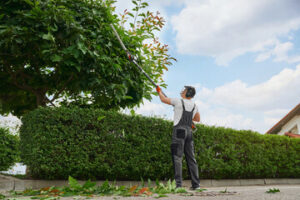Best Laser Hair Removal is a permanent way to remove unwanted hair. The heat from the laser destroys the hair follicle, which prevents it from growing new hair. It’s also safer than shaving, plucking or waxing.

It works best on people with light skin and dark hair because the contrast in pigment makes it easier for the laser to target the follicle. You should avoid sun exposure and use a broad-spectrum sunscreen before and after treatment.
When you choose to have laser hair removal, you are taking a proactive step towards smooth skin. This procedure eliminates the need for shaving, waxing and tweezing to get rid of unwanted hair on your body. It also helps to prevent ingrown hairs which are painful and embarrassing. The process is also safe and less invasive than alternatives like electrolysis. The procedure is performed by a certified technician who has been trained to use the appropriate equipment to perform the treatment.
Laser treatments are highly effective and permanent when performed by an experienced physician or technician. During your consultation, you can ask about the experience and training of the technician performing your laser hair removal. You can also check whether they are on a register that shows they meet set standards of training, skill and insurance.
After your treatment, you can enjoy a period of smoothness that lasts for years. The hair that does grow back is usually much thinner and softer than before, which creates a more natural look. However, younger patients or those who go through hormonal changes may require regular re-treatments.
You can also save time and money on beauty products like hair gels, razors and shaving cream. In addition, you no longer have to deal with the hassle of scheduling appointments or waiting for your hair to grow out between sessions. Additionally, you can avoid ingrown hairs and other unpleasant side effects of shaving or waxing, such as prickly stubble. The treatment is also much faster than alternative options like plucking or shaving, which can take a long time and leave the skin feeling uncomfortable. The result is silky smooth skin that will improve your self-image and boost confidence.
Cost
There are many factors that determine the cost of laser hair removal. Some of these include surgeon fees, geographic location and the body area being treated. It is important to discuss the costs of your desired treatment with a specialist before making a final decision.
The average cost of a laser hair removal session is $389, according to data from the American Society of Plastic Surgeons. This includes the office visit, application of topical numbing cream and laser treatment. However, it doesn’t include the cost of additional treatments. It typically takes several sessions for laser hair removal to work and permanently reduce unwanted hair growth from the body.
It is also important to note that laser hair removal is considered a cosmetic procedure and is not covered by health insurance. However, if you have a flexible spending account or health savings account, you may be able to use these funds to pay for your treatments.
Although the initial investment for laser hair removal is higher than shaving or waxing, it will save you time and money in the long run. Plus, it is an investment in your skin’s health and well-being. With regular hair removal methods consuming hours of your life every week, the initial price tag for laser hair removal is often worth it in the end. If you are ready to get rid of unwanted hair, contact Manhattan Aesthetics for a consultation and laser treatment today.
Preparation
If you’re considering laser hair removal, the first step is to consult with a licensed dermatologist. They will assess your skin type and recommend a treatment plan. It’s important to follow the recommended schedule, as irregular sessions may reduce the efficacy of the treatment.
The next step is to prepare the skin for laser hair removal by exfoliating it and removing any dead skin cells. This will make the laser’s heat more effective by targeting only the target hair follicle and not the surrounding tissue. You should also moisturize the area to keep it hydrated. This will help with any redness that occurs after the session.
In the days leading up to your laser hair removal session, it’s best to avoid any skincare irritants. This includes perfumes and fragranced creams. In addition, you should avoid caffeine, as it can make your skin more sensitive and increase the likelihood of pain or discomfort during the procedure.
It’s also essential to shave the treatment area before your appointment, as this makes the hair easier to target with the laser’s heat. However, you should never wax or pluck the area before your laser session. Additionally, you should avoid bleaching the area, as this will make it more difficult for the laser to target the hair roots.
It’s also important to inform your technician about any medications that you are currently taking. This is essential because some medications can heighten sensitivity to the laser’s effects. By letting your technician know about your current medication regimen, they can optimize the treatment to fit your unique needs. For instance, they can adjust the power or pulses of the laser to ensure that your skin doesn’t react adversely.
Side effects
Laser hair removal produces less side effects than other traditional methods of removing unwanted hair, such as threading and waxing. The procedure is also more precise and does not damage the surrounding skin. However, the American Academy of Dermatology warns that it may take multiple treatments to achieve desired results. It is important to discuss your goals and expectations with a doctor or hair removal specialist to determine the right treatment plan for you.
The most common side effects of laser hair removal are redness, swelling, and temporary discomfort. These symptoms usually occur within the first few hours after your session. To reduce the pain, you can apply a cool compress or hold an ice pack on the treatment area. It is also essential to avoid sun exposure before and after laser hair removal to prevent any potential complications.
A qualified dermatologist can help you find the right laser treatment for your skin and hair color. During the consultation, you can ask questions about the treatment and its risks. The dermatologist will also evaluate your hair color and skin type to ensure that the treatment is safe for you.
Patients who have a light complexion and dark hair typically have the best results from laser treatment. This is because the pigment of the hair absorbs the laser light, causing it to destroy the hair follicle while avoiding damage to the surrounding skin. Patients with blond or gray hair are less likely to benefit from laser treatment, as the pigment in these hairs does not absorb the laser light.
Most people see hair regrowth after laser treatment, but the hairs that do regrow tend to be lighter and thinner. In addition, it is possible to perform repeated laser treatments over time to decrease the number of hairs that grow back.
Results
Compared to traditional methods of hair removal, laser treatments provide much faster results. However, you will need to undergo multiple treatments before you notice a significant reduction in your unwanted hair. Your laser specialist will work with you to create a timeline that best suits your aesthetic goals. You should avoid plucking or waxing the area before treatment to help preserve the integrity of your skin. The laser works by targeting chromophores, or pigments, in the hair follicles. Darker hair follicles are more likely to respond to the laser than light or blond ones. However, laser treatment is not effective for white or gray hair because it lacks the necessary melanin for a successful result.
The length of time it takes for your skin to respond to laser treatment depends on the thickness of your hair and the size of the area being treated. Thinner hairs typically require more treatments than thicker ones. It also depends on where the hair is located. For example, the upper lip and chin tend to have slower response rates than the chest, back legs, or axillae.
Another factor that influences the effectiveness of laser hair removal is the anagen-telogen ratio of your hair. A large percentage of your hair must be in the anagen phase for it to respond to laser treatment. However, attempts to correlate anagen-telogen ratios with laser treatment have been unsuccessful.
Unlike other forms of hair removal, laser treatments offer permanent results for most people with dark hair. Nevertheless, most patients will need touch-up sessions once or twice a year to maintain their desired appearance. Nonetheless, laser hair removal is a safe and effective solution for those with excessive hair growth, such as women suffering from the condition known as hirsutism.





